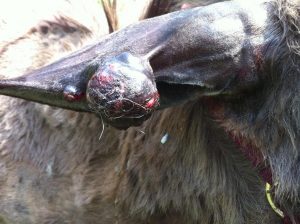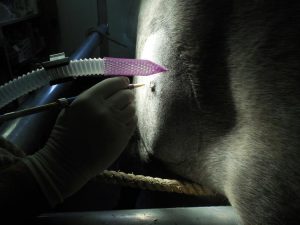 What is a sarcoid? Should I be worried if my horse has one? What is the best way to treat sarcoids? These are the questions many horse owners ask if their equine companion is diagnosed with a sarcoid.
What is a sarcoid? Should I be worried if my horse has one? What is the best way to treat sarcoids? These are the questions many horse owners ask if their equine companion is diagnosed with a sarcoid.
A sarcoid is a skin neoplasia (abnormal growth). A characteristic that differentiates sarcoids from other skin growths is that there is a proliferative epithelial component1. This means that there is excessive growth of the outermost layer of the skin. Sarcoids are typically considered benign tumors because most are slow growing and do not affect the overall health of the horse, however there are very rare exceptions which can become malignant. Sarcoids are classified into different types based on how they look and act. These types range from occult saroids, which appear as a flat hairless region of skin that may be unchanged for many years, to malevolent sarcoids that infiltrate under the skin and grow rapidly. Verrucous or wart-like sarcoids and nodular or round, spherical sarcoids are other common types. Mixed sarcoids contain characteristics of multiple types of sarcoids. For example they may be round with a wart-like surface. Many sarcoids can be accurately diagnosed based on what they look like, however in order to be completely certain of a diagnosis, a section of the suspected sarcoid must be submitted and evaluated under the microscope.
Extensive research has gone into determining the cause of equine sarcoids. The development of a sarcoid is likely due to a combination of factors including genetics, exposure to certain viruses, and trauma. Certain breeds of horses and the presence of particular genes within a horse breed have been shown to be associated with increased incidence. In one study Quarter horses were found to be at increased risk, while Standardbreds had a much lower risk2. Exposure to bovine papilloma virus, a virus that causes warts in cattle, has also been shown to be associated with the development of sarcoids, although only certain horses affected with this virus will develop a sarcoid3. Sarcoids are often found at the site of a previous wound, suggesting that trauma may also play a role in their development. It is likely a combination of multiple factors that results in the development of a sarcoid.
Treatment of sarcoids can be challenging. No one treatment is fool proof and often multiple treatments are combined. Sarcoids can re-occur with a vengeance, so continued dedication to treatment on the part of the owner and veterinarian is very important. Many scientific studies have been conducted to evaluate treatment methods for sarcoids. It can be difficult to compare these studies as they often look at different types of sarcoids. You can imagine that the success rate published with one technique that reports removal of small sarcoids that have never been treated before would have better results that a study looking at a different treatment that was used on large sarcoids that have already been treated many times and have re-occurred. If your horse is diagnosed with a sarcoid, you and your veterinarian will weigh multiple factors to determine the best course of action for your horse.
Some small, flat sarcoids that are not in a location that causes a problem for the horse or that interferes with riding may just be left alone and monitored. It is important to keep a close eye on these sarcoids. If they start to grow, they should be treated before they are allowed to become large.
Simply removing the sarcoid is one of the least successful treatment methods. Often the sarcoid rapidly returns and is even larger than before it was removed. Studies looking at surgical removal alone report re-occurance rates (the sarcoid comes back) of up to 82%4.
 Removal with a surgical laser has a much better reported success rate. The laser causes less trauma and reduces the spread of abnormal tumor cells. This procedure is quick and often does not require general anesthesia (where the horse is laid down and kept completely asleep for the procedure). It does however require that the horse be transported to a veterinary hospital for treatment. A large study reported a re-occurance rate of 38%5.
Removal with a surgical laser has a much better reported success rate. The laser causes less trauma and reduces the spread of abnormal tumor cells. This procedure is quick and often does not require general anesthesia (where the horse is laid down and kept completely asleep for the procedure). It does however require that the horse be transported to a veterinary hospital for treatment. A large study reported a re-occurance rate of 38%5.
Cryotherapy or freezing of the sarcoid tissue has been one of the most common treatment methods. This treatment involves freezing the tumor tissue with a probe chilled by liquid nitrogen. It can often be done on the farm, but multiple treatments are necessary especially if the sarcoid is large. Early studies reported good success rates, but a more recent study that looked at outcomes over a longer time period reported high re-occurance rates4.
Sarcoids can also be treated by injection with the chemotherapy drug cisplatin. This treatment can also be combined with surgical removal or surgical laser removal. Reported reoccurrence rates vary between 13-66%1. Topical application of the chemotherapy drug 5-flurouracil was shown to be successful when applied daily for 15 days on small sarcoids. This cream also causes significant inflammation and discomfort to the site where it is applied, so repeated application can be challenging as the horse is often resentful of its application4. Xterra a product that contains bloodroot has also been reported to be successful, however there are no current scientific studies evaluating this product for the treatment of sarcoids.
Immunotherapies have also been used to treat sarcoids. One type involves the injection of the cell wall of a certain type of bacteria. This does not cause an infection with that type of bacteria, but does cause the body’s immune system to be super stimulated. The immune system then recognizes the sarcoid as a tumor cell and attacks it. These therapies require multiple injections and result in severe tissue swelling at the site of the sarcoid. In rare instances severe and even life threatening anaphylactic (allergic) reactions can occur4.
Various types of radiation therapy have been used with very good results. Reoccurrence rates are as low as 1- 12.5% of cases. Radiation therapy is very expensive and can only be performed at a few university hospitals. Depending on the type of radiation therapy it can require multiple episodes of general anesthesia per week for 3-4 weeks or complete isolation of the horse for several days to weeks6.
After reading this long list of treatment options, it is easier to appreciate why it is important to discuss the multiple options with your veterinarian and determine the best course of action for your horse. The good news about sarcoids is that they are very rarely life threatening and the majority do not affect a horse’s athletic potential. With appropriate therapy most sarcoids can be successfully treated and your horse can go on to live a long, happy, productive life.
References
- Carr, EA. Skin Conditions Amenable to Surgery. Equine Surgery
- Angelos J, Oppenheim Y, Rebhun W, et al: Evaluation of breed as a risk factor for sarcoid and uveitis in horses. Anim Genet 19:417, 1988.
- Carr EA, Theon AP, Madewell BR, et al: Presence of bovine papilloma virus DNA in equine sarcoids in horses living in the Western United States. Am J Vet Res 62:742, 2001.
- Knottenbelt DC, Kelly DF, The diagnosis and treatment of periorbital sarcoid in the horse: 445 cases from 1974-1999. Vet Ophthalmol 3:169, 2000.
- Carstanjen B, Jordan P, Lepage OM: Carbon dioxide laser as a surgical instrument for sarcoid therapy: A retrospective study on 60 cases. Can Vet J 38:773, 1997.
- Byam-Cook KL, Henson FM. Slater, JD: Treatment of periocular and non-ocular sarcoids in 18 horses by intersitisal brachytherapy with iridium-192. Vet Rec 159:337, 2006.